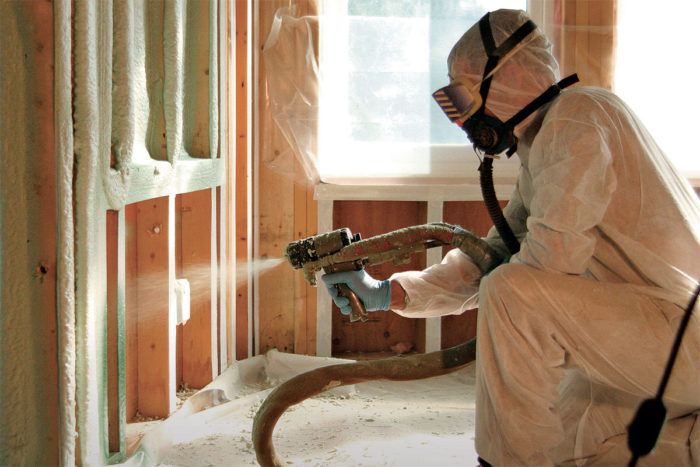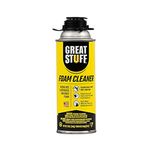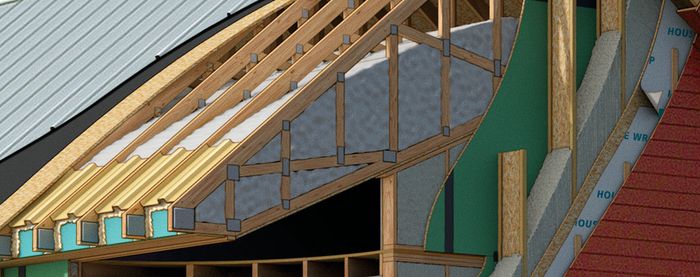Is Using Closed-Cell Foam Worth the Trade-Offs?
This insulation material is popular for its high R-value and good air-sealing and vapor-blocking properties, but cost, health, and environmental concerns cause some builders to have second thoughts.

Synopsis: Contributing editor Michael Maines takes a detailed look at closed-cell spray foam, which is growing in popularity as an insulation material. Maines identifies its advantages—a high R-value per inch, a capacity for air-sealing and for blocking water-vapor movement, and its enhancement of the framing-to-sheathing connection. He then discusses its disadvantages—including high cost, messiness and potential health risks, and the fact that it can’t be used in many transitional areas where air leakage is high. But Maines focuses primarily on closed-cell foam as a contributor to global warming because of the blowing agent that is used in most closed-cell foams, which is over a thousand times worse than carbon dioxide.
Closed-cell polyurethane spray foam is amazing stuff. It’s a great insulator, with a higher R-value per inch than almost any other commonly available material. (Polyisocyanurate foam can be equivalent, but it varies with product and temperature.) When installed at least an inch or two thick, it essentially blocks water vapor and air movement. It even has some structural benefits: It’s good at adhering sheathing to framing, and it also enhances racking resistance. Thanks to these qualities and more, including strong marketing from the industry, foam is only getting more popular. Unfortunately, it also has some serious issues that aren’t typically discussed outside of greenbuilding circles. Understanding these drawbacks may convince you to limit its use to those special situations in which it makes the most sense, or even to avoid it entirely.
Polyurethane foam starts as two containers of liquid chemicals, referred to as the “A” side (isocyanates, the primary component of the solid foam) and the “B” side (a blend of resins, catalysts, a blowing agent, a flame retardant, and other compounds). When combined at installation, the chemicals react to create a polymer filled with tiny bubbles. The bubbles, or cells, are filled with a blowing agent and provide the insulating value, while the polymer forms the cell walls.
The ingredient that makes closed-cell foam special is the blowing agent—typically HFC245fa—but that’s also its biggest drawback.
HFC245fa is a hydrofluorocarbon refrigerant and a persistent greenhouse gas; it goes up into the atmosphere and stays there, preventing heat from escaping the earth. Carbon dioxide is commonly used as a measure of the damage a greenhouse gas can do, and HFC245fa is considered 1030 times worse than CO2. The only common building product more potent is the blowing agent in conventional XPS rigid foam. According to the Environmental Protection Agency, “Although [HFCs] represent a small fraction of the current total volume of [greenhouse gas] emissions, their warming impact is very strong. HFC emissions are projected to increase substantially over the next several decades if left unregulated” (from EPA Rule 21 Fact Sheet).
Some analyses have shown that the energy savings from closed-cell foam may never offset the environmental damage done. According to the technical director of the Spray Polyurethane Foam Alliance, Richard Duncan, PE, the blowing agent is 6% by weight of the foam. An average house with a basement that is fully insulated with spray foam may have 4000 lb. of foam to meet code in a cold climate. That means 240 lb. of blowing agent, equivalent to 250,000 lb. of CO2. A tenth of that is released shortly after installation.
The emissions from any one project or even a lifetime of one builder’s projects may not make a measurable impact on the environment, but if a large portion of the building industry shifted away from products with potent greenhouse-gas emissions, it would make a big difference. Buildings account for up to 50% of greenhouse-gas emissions, the United States is responsible for more than 25% of that, and spray foam is one of the worst offenders in construction. In fact, the federal government has mandated that the HFC245fa blowing agent no longer be used in spray foam as of January 1, 2020.
Fortunately, there is already a more environmentally friendly option, a closed-cell foam that uses an HFO (hydrofluoroolefin) blowing agent called Solstice, made by Honeywell, which is a much less potent greenhouse gas. Equivalent to carbon dioxide, it still has higher embodied carbon and is more damaging to the environment than most nonfoam insulation, but it’s better than conventional closed-cell foam. Several brands and product lines of foam are now using this blowing agent, such as Lapolla Foamlok 2000 4G, Demilec HFO High-Lift and HFO Pro, Icyene ProSeal HFO, and EcoBay from BaySeal.
HFO-blown foam is not only better for the environment, but it has other benefits as well: Because of a lower-temperature chemical reaction, it can be safely installed in thicker lifts—up to 6-1⁄2 in., depending on manufacturer, versus a maximum of 2 to 3 in. for conventional foam, which saves time. Field reports say that the cell structure appears more uniform than in conventional foam, meaning there’s a better chance of getting what you expect. Perhaps best of all, as the foam gets thicker, the R-value per inch increases to a larger degree than with other types of foam. HFO-blown foam costs more to purchase, but one installer I know said he was able to bring down his cost to the customer due to the labor savings.
Another environmentally friendly blowing agent, water, is typically used only in open-cell foam, but Icynene offers a water-blown closed-cell foam called ProSeal Eco. Its R-value (R-4.9 per in.) is lower than that of other closed-cell foams but higher than that of air-permeable insulation. As for the polymer part of the foam, insulation may be the best use we have for petroleum, but it comes with high embodied carbon, the measure of what it took to make the product. According to data from BuildingGreen, on a per-R-value basis, its embodied carbon is about twice as high as that of fiberglass, and 12 times more than cellulose. And because the chemical reaction to turn liquid resin into rigid foam is a sensitive one, things can go wrong. For example, an improper cure leaves an odor, which may cause health problems. I know of a few people who decided to rip out improperly cured foam, as well as others who live with the odor—under the promise that someday it will go away. Some types of foam are manufactured using soy derivatives and recycled content in place of some of the virgin petroleum resin, which is admirable, but the blowing agents have a much bigger impact on the carbon footprint.
Most insulation is nasty to work with to some degree, warranting personal protective gear. But spray foam is in its own class; it’s the only one that requires a supplied-air respirator (no cartridge filter is capable of protecting against the fumes) and full-body suit to protect against short-term and cumulative health effects from the components in uncured foam. (Search “isocyanate exposure” for a long list.) Once foam is properly cured, most sources show no significant health risks. People who are sensitive to odors have told me that improperly cured foam causes headaches and throat irritation, and even foam considered properly cured has an odor that they can detect; however, no health concerns appear on material safety data sheets for properly cured foam.
Despite the drawbacks, I am not opposed to foam; sometimes the work-arounds to avoid it border on the ridiculous, even in the opinion of a dedicated tree hugger like me. There are things foam can do that other products simply can’t do. Installers seem to be slow to adopt HFO-blown foams, and even sustainably minded architects and builders I know did not realize it was on the market. (Start demanding it, and supply will react accordingly.) But in most situations on most projects, with an understanding of building codes and building science (and perhaps a bit of creativity), you should be able to find a system that insulates just as well (or better) than foam, with less expensive, more environmentally friendly, and more resilient materials.
Insulating valuePro
Con
Air-sealingPro
Con
Environmental impactPro
Con
Vapor blockingPro
Con
|
SafetyPro
Con
Sticky and structuralPro
Con
ExpensePro
Con
|
Update from the author:
A couple of representatives from the spray-foam industry offered two corrections to my article.
- Honeywell has been making its Solstice low-GWP (global-warming potential) blowing agent for about four years, but another company, Chemours, has a similar blowing agent, called Opteon, which some foam manufacturers are using instead of Solstice. Opteon has been available since late 2017.
- I noted that the federal government had mandated a move away from HFC blowing agents by January 2020. It’s true that they had, but Brett Kavanaugh struck the rule down when he was a judge for the U.S. Court of Appeals. My research had indicated that he had only ruled against the portion of the regulation regarding refrigerants, but it was actually the entire thing. The day after the UN released its devastating report, the U.S. Supreme Court decided not to hear an appeal to the rule being rescinded, as the EPA no longer supports that type of regulation.
Also, my wording for the section about the quantity of foam in an average house wasn’t clear. An average-size house of about 2400 sq. ft.—either a single-story home on a slab with an insulated cathedral ceiling, or a two-story home with an insulated attic and a spray-foamed full basement insulated to meet code in one of the colder climate zones—requires between 4000 and 5000 lb. of foam. That’s using the LTTR (aged R-value) for foam.
To view the entire article, please click the View PDF button below.
More about spray-foam insulation:
- Spray-Foam Problems
- Spray Foam for the Rest of Us
- What’s the Difference: Open-cell vs. closed-cell polyurethane-foam insulation
Fine Homebuilding Recommended Products
Fine Homebuilding receives a commission for items purchased through links on this site, including Amazon Associates and other affiliate advertising programs.

Nitrile Work Gloves

Great Stuff Foam Cleaner

Staple Gun



View Comments
Closed cell has been my only choice since using on a mid 90's project. I'm a serial remodeler -- often very old (1810/ 1870) or unusual buildings (fire house/church). Foam allows a coating in very tight or thin areas when space does not allow 6" of another material -- or even 4". Even 1" of close cell is amazing stuff for both insulation and air sealing. Foam transformed my drafty, inefficient and more importantly uncomfortable cape at the beach a few years ago. A few inches on my 1810 federal in the city 20+ years ago ... a full 4+ inches on my new project expanding a Pa stone building. Also, lived though a fire w/ foam -- the fire cut through the wood rafters and broke through the windows before burning through any foam. The foam eliminated any passage for the fire (and smoke) to find it's way through the structure. I can't comment on the environmental aspect -- except to say structures use smaller HVAC equipment and are energy efficient.
I am frustrated that the article doesn't address the foams that are out there that use a different blowing agent. I don't have any experience with them but I have heard about them (probably from FHB and the podcast) multiple times. Is nobody using them? Are they not really available?
... (pause, use Google)
After some quick research, including a story from Green Building Adviser almost 2 years old, there are closed cell foams with other blowing agents out there including a generally available product from honeywell with a Ozone score of 1, same as CO2. After 5 minutes of web research this posting sounds more like a ill informed opinion than the type of information FHB usually publishes.
There's this guy at the University of Alabama, Huntsville, who runs NASA's satellite remote temperature sensing program. I know he's not a contractor, but he swears there has been no increase in atmospheric temperatures. Another guy--not a contractor--was professor emeritus in atmospheric sciences at M.I.T. for 40 years. He says that we really shouldn't panic over a 2 degree projected temperature change in 100 years. Take that with a grain of salt, because, like I said, he's not a contractor.
I'm eagerly awaiting a paper written by Princeton physicist whatshisname on the proper way to flash chimneys when using metal tiles.
Albany_Chris, if you read my entire article, you'll see that I discuss low-GWP blowing agents.
Justacabinetguy, climate scientists aren't concerned with atmospheric temperatures; they measure an average of surface and ocean temperatures. It's true that there is not 100% agreement among the scientific community that we have a problem. Merely 97 out of 100 scientists worldwide are concerned.
Unfortunately you're quoting a bogus "fact" that a thoughtful person ought to question. It's a shame that the truth about atmospheric gases isn't better known, but I hope you'll avoid giving so much attention to alarmist concerns in future articles. Let's focus on known homebuilding challenges, not alarmist worries about the possibility of some slight warming (which would be a blessing for those of us up north).
ddwieland, which fact are you claiming as bogus? We are already seeing the early results of climate change, and if the current predictions are accurate (2° to 7° rise this century) the results will be significant, to say the least.
The predictions are never right but get ever more extreme, but the climates (yes, climate is regional) stubbornly refuse to play along. Slight warming is followed by slight cooling is followed by more warming then cooling and so on. Trends in the past were much steeper than in our remarkably stable times. Please don't confuse occasional extreme weather events with signs of climate change. Even NOAA and the (rarely read) science sections of IPCC reports don't make that claim, just Al Gore, enviro-radicals and headline hunting media. But we should try to build for extreme weather and avoid building in predictable trouble zones. That's where we can actually do some good. What we know is that there will be storms and floods. Let's build with that in mind.
ddwieland, I don't know where you get your "facts" but even the white house is predicting a 7° temperature increase by the end of this century. The vast majority of climate scientists are in agreement that we are in the midst of a catastrophe. "Occasional extreme weather events" don't account for collapsing ice shelves, crashing insect populations, crashing fish populations and other results of ocean acidification.
I also didnt see any real discussion of low GWP products and I searched the article several times. The only thing I can find in the article is the statement that : "HFC emissions are projected to increase substantially over the next several decades if left unregulated". In fact, closed cell spray foam insulations (high pressure type) will have to use the new HFO blowing agents by Jan 2020, and that these new blowing agents are already available in products used today and have a GWP of just 1. This would completely eliminate this concern in the article. This information was not mentioned yet is readily available, and useful to readings looking into this discussing this topic.
This article states that "high embodied carbon, the measure of everything it took to make the product". Checking other sources, “embodied carbon” refers to carbon dioxide emitted during the manufacture, transport and construction of building materials, together with end of life emissions. Maybe” embodied energy” was the better metric to bring up here.
Sure its probably one of the single best uses of petroleum, but first of all, polyethylene bags and water bottles are mostly a byproduct of natural gas production and do not really effect the resource. A good next step in this conversation would be to talk about a life cycle analysis when mentioning resources and embodied energy (see the LCA completed on spray foam insulation which was also done to full ISO standards). Its interesting to look at the OTHER uses of petroleum other that what is combusted or used as lubrication. These other products end up using up a very small fraction of a barrel of oil. When you then look at the fraction used in a product like spray foam insulation it gets silly small. I have also been told that approximately 40% of spray foam insulation comes from other than petroleum sources.
The article states "whatever it touches is essentially ruined"? This is bit of an over exaggeration, and might indicate an unfounded bias. Sure its harder to remove than batts, but do you want to cripple your envelope for 50 to 100 years so its easier to remodel?
SDI1, did you click on "view PDF," as noted at the bottom of the preview? Almost the entire last page was omitted from the preview, including the discussion of HFO blowing agents. The quote about HFC emissions was pulled directly from the EPA fact sheet.
The EPA rule 21 that had been accepted by the Federal government, to require low-GWP blowing agents by 1/1/2020 was struck down by Brett Kavenaugh. My research had shown that he had just blocked the portion of the law that affected refrigerants, but this week I confirmed with Rick Duncan, technical director of the spray foam alliance, that the entire law was nullified. So the discussion is still valid, as it's now going to have to be a market-driven change, as apparently protecting our environment is the last thing the current administration wants to do.
Neither "embodied carbon" or "embodied energy" have universal, specific definitions. For the purposes of my article, they are equivalent. Bruce King and his contributors write more about this topic in his book, The New Carbon Architecture.
When you provide a market for a byproduct of resource extraction, as with polyethylene and gas production, you are still supporting the resource extraction. We could go deep into a discussion about various plastics and their production methods; I find chemistry and plastics to be an interesting topic. As it is we had to cut about half of what I had wanted to include, and I think most people would understand that my point was rhetorical. Of course there are other areas where a lot more petroleum is used, but this is an article about spray foam. I've tried to read the LCA but it's not easy to understand. With global warming a priority, lifecycle costs are much less important--what matters is the carbon (or, more properly, carbon dioxide equivalent) we emit over the next few years, so any insulation that is not plant-based is a poor choice except when nothing else will work. 40% of spray foam insulation comes from sources other than petroleum? I'm dubious without a reference.
Yes, whatever spray foam touches is essentially ruined. Starting with a lot of my own clothes... Have you ever tried to renovate a home with spray foam insulation? Have you ever advised homeowners on how to remove foam that did not cure properly? How about cleaning up foam sprayed during retrofits that either splattered over existing finishes, or that melted due to the temperatures being too cold for the mix? Have you tried to pull wires through foam? One foamed, they are in there permanently. I have done all of the above, and stand by my statement. Perhaps you have not done a lot of renovating, or live in an area of new homes. Most homes will eventually be renovated, and although not critical, it's a whole lot easier when the assemblies are made to be repaired, something that used to be common in every field but that in our throwaway society is under-appreciated.
Your claim that a home without spray foam will "cripple the envelope" is a serious exaggeration. My personal experience is that homes with spray foam have a much higher chance of problems developing than homes without foam. I don't have data on that and doubt any exists, but it would be interesting to study.
Why do you have to bring your political prejudices into an article about insulation? Brett Kavanaugh did not strike down Rule 21, the court did, BK simply wrote the decision. I'd also note the EPA agreed with the decision and changed the Rule and that the Supreme Court basically upheld the decision when they refused to hear the case.
At the time I wrote this article, Brett Kavanaugh was in the news daily. I don't see how mentioning his name is stepping far into politics. He wrote the majority opinion of the court of appeals. I try to minimize discussion of politics, but politics is not separate from life, building, design or the environment.
I see no reason to have a house be 100% closed cell foam or 100% conventional insulation. For a bathroom where there is blocking to support grab bars or plumbing in an exterior wall then the closed cell foam is far more effective and far easier to apply than glass or other insulation material.
The attic is a different situation from the walls of a house with different constraints and concerns. Big variation in mitigation costs with a bad closed cell foam installation depending upon where it is applied.
No need to post ignorant comments about global warming which is agreed upon by 100% of those scientists not on the pay of the Koch brothers and the energy industry. One can always pay people to lie and all that is surprising is how so many people place so little value on their personal integrity.
Michae, I’m shocked at some of your comments. I have to assume your the lowest price guy in your area. When a professional spray foam company is hired there should be no overspray to be cleaned up. There should never be any resin as you mentioned as unmixed foam. EVER. These are common issues found when you have untrained professionals (being nice) installing spray foam. Remember this when your bidding your next project. The old saying is still true today “you get what you pay for”. As for closed cell vs fiberglass. I run a company that does primarily old renovated buildings and homes. I can tell you I have pulled 15-20 year old fiberglass out that was deteriorating so bad it had zero ability to perform. Even at an R5 per inch closed cell will still out perform any fiber product even on their worst day. A typical wall in 20 years will have an R value of 15 vs effectively zero with fiber. I won’t get in to Q factor because it will go into a whole other conversation. At the end of the day closed cell spray foam is superior to ALL fiber products we have access to today. You covered the HFO but it’s been around for a few years I’m shocked you didn’t know about this and include it in your article as a huge positive. Seems like your writing is biased and not 100% factual. When home owners and professionals read your publication we should have all the facts presented in a manner that allows us your readers to make an informed decision.
IDR_1, I did know about HFO-blown, and included it in the article. In fact one of the main reasons I wrote this piece was to share that HFO was available, as very few installers in my area are using it. I just had not found that there was another manufacturer of an HFO blowing agent besides Honeywell, who supplies most foam companies and has gotten most (nearly all) of the press. The technical director of the Spray Foam Alliance could not disagree with anything I wrote except what I noted, so I'm not sure that I'm the biased party here...